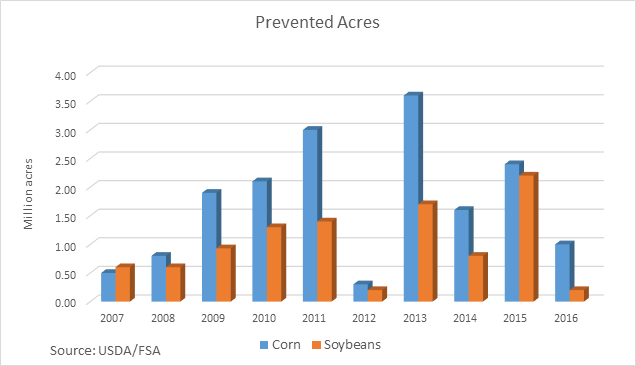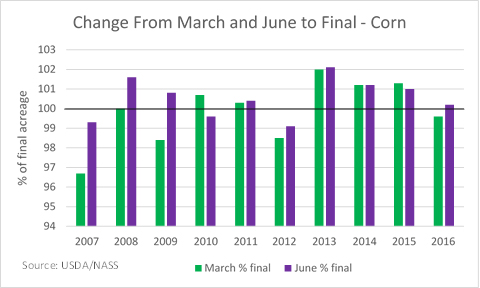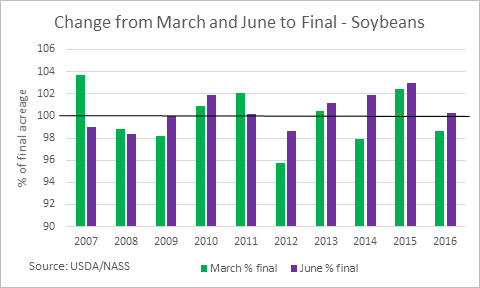It has been a stormy couple of weeks in much of the Corn Belt. Corn planting was only 6 percent complete through April 16, compared with a 9 percent five-year average, according to USDA’s weekly Crop Progress report. Fields are wet, with 18 percent having surplus moisture, and soggy conditions could last into May from Kansas to the Mid-Atlantic coast.
This has traders are wondering if even more acres will shift from corn to soybeans. Based on the USDA’s Planting Intentions March 2017 survey, farmers planned 90 million acres of corn, down 4 percent from last year but 2 percent above 2015. Soybeans were reported at a record 89.5 million acres.
There are a few ways to assess how weather delays could affect planted acreages.
Prevent Plant
A look at 10 years of reported prevent plant history for corn shows as much as 3.6 million acres in 2013; the largest reduction in soybean acres was in 2015, at 2.2 million acres. The chart also highlights that soybeans have fewer prevented acres than corn every year but 2007.

One can’t assume that every prevent plant acre comes off the intentions, because producers in areas with favorable weather may swing to more corn than originally intended – especially if they think acreage will be lost elsewhere.
In 2013, for instance, 3.6 million acres of corn and 1.7 million acres of soybeans were reported as prevented. In March, producers planned 97.282 million acres of corn. In June, the number of reported corn acres rose to 97.379 million, only to fall to 95.365 in the final acreage report. That was a reduction from March of 1.9 million, not the 3.6 million that was prevented. Similarly, in March, producers planned to plant 77.1 million acres of soybeans; in June they reported 77.7 and by the final report, acreage had dropped to 76.8 million, a reduction of 286,000 from March but well below the 1.7 million prevented.
Track Record
Another historical measure that offers perspective regarding how much acreage can change is the difference between the March intentions report and the June planted acreage report versus “final” acres reported in January. In the past 20 years, the average change between the March report and the final acreage report was just above 1 million acres. The March report was below the final acreage eight years and above, 12 years.
The difference between the June corn report and the final estimate averaged only 652,000 acres, with the smallest 28,000 and the largest 2 million.
Soybean acreage in the March report differed more than in the final report – an average of 1.26 million acres. March intentions were below the final number 10 years and above 10 years.
Soybean acreage also is closer to final acreage by June, with the average at 847,000, the smallest difference, 32,000 and the largest, 2.49 million.
On a percentage basis, the biggest change in corn acreage in the past 10 years from March and June occurred in 2013. Soybeans, on the other hand, saw their biggest change from March to final in 2007, when acres fell almost 4 percent. The biggest change from the June report was in 2015 – planting came in 3 percent lower.


Yield reduction?
Reduced yields often can be seen once planting is delayed past mid-May, said Paul Jasa, a University of Nebraska agricultural engineer and no-till proponent.
“Research indicates that you’ll typically start seeing yield losses on corn planted after May 15,” Jasa said. “It can go down 1 percent for every day after that.”
A study from the Monsanto Learning Center at Monmouth, Ill., concluded: Early April through mid-May provides the optimum planting date and may permit 97 to 100 percent realization of yield potential. The early part of the window allows more days for plant development; reduced pest pressure; earlier pollination, which reduces potential for heat stress; and earlier maturity and dry down. Losses of 1 to 2 bu./acre/day is likely in late-planted fields, the report said. If drought or other weather events take over later in the season, they may have as big or bigger an impact.
Bottom line: The markets may react to planting delays – but keep in mind that early worries don’t necessarily match up with final acreage. Frontier Farm Credit lenders urge customers to update their crop budgets as the season progresses to reflect changes in acreage planted, expected yields and prices.

